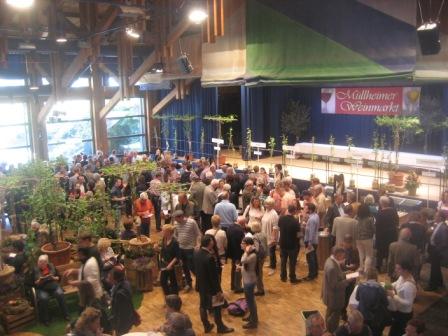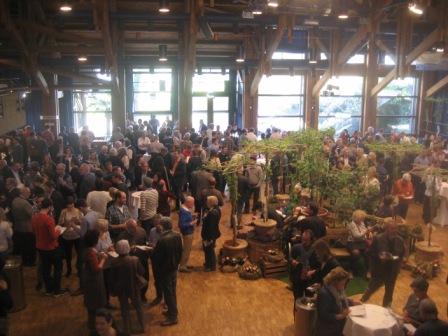 At long last, I attended the annual (and 134th) Müllheimer Weinmarkt yesterday. The Weinmarkt in Müllheim is a one-day event that normally takes place on the final Friday in April, hot on the heels of the presentation of the annual Gutedel Cup awards in the nearby spa town of Badenweiler. Held at Müllheim’s municipal functions hall, the Bürgerhaus, the Weinmarkt gives the public a chance to taste through the entire spectrum of wines produced in the region of Markgräflerland.
At long last, I attended the annual (and 134th) Müllheimer Weinmarkt yesterday. The Weinmarkt in Müllheim is a one-day event that normally takes place on the final Friday in April, hot on the heels of the presentation of the annual Gutedel Cup awards in the nearby spa town of Badenweiler. Held at Müllheim’s municipal functions hall, the Bürgerhaus, the Weinmarkt gives the public a chance to taste through the entire spectrum of wines produced in the region of Markgräflerland.
Unlike similar tastings, the producers themselves aren’t the ones pouring the wines. Instead, the various stands are categorised according the various grapes – from Gutedel and Weissburgunder, through to Sauvignon Blanc and Spätburgunder. Behind each stand, women in traditional Markgräfler dress serve the different wines. For example, Gutedel – which, alongside Spätburgunder, was easily the most populous category – boasted a total of 73 wines. All I needed to do was tell one of the women the number – as indicated in the official programme – of a particular wine I wanted to taste, and she would then pour me that wine. Simple really, and quite refreshing if you just want to focus on the wines and not be looked up and down by someone quizzing you every minute as to what you (think) you can taste.
That said, the Müllheimer Weinmarkt is very much a social gathering. First, you had the lengthy intros at the beginning, featuring speeches from local bigwigs, the customary handful of wine princesses, and Markus Büchin (of Haltinger Winzer and Weinhaus Büchin), the new head of local wine association Markgräfler Wein e. V. Only after this seemingly never-ending purgatory of proverbial backslapping on the stage (around 45 minutes of me regretting that I’d arrived so early) were the public able to start tasting the wines. I once attended a similar local event up in the Pfalz, but at least the organisers back then had the good sense to shoehorn their speeches into proceedings while people already had wine in their glasses … Second, it felt like many had simply turned up for a few nice glasses of Gutedel and a good old chinwag. Indeed, the Gutedel stands were the most crowded. However, I eventually managed to taste my way through a good cross-section of what Markgräflerland’s most popular grape has to offer. This in itself was informative and worthwhile – I can’t think of many other events that offer such a broad overview so efficiently.
So, what were my impressions of the wines? Starting with Gutedel, the wines that impressed me the most were the ones that had minimal residual sweetness – fermented virtually bone dry with no more than, say, 2 or 3 g/l of RS, but still tasting light and balanced. This was definitely the common thread separating the wheat from the chaff. Wineries that stood out in my mind in the Gutedel category were Claus Schneider from Weil am Rhein (with their distinctly mineral Weiler Schlipf), Schlossgut Istein (big surprise), H. Schlumberger from Laufen, Dörflinger from Müllheim, Blankenhorn from Schliengen, and (another big surprise) Röschard from Weil am Rhein. That is not to say that some wines up around the 4-to-6-g/l range weren’t very good, but others for me tasted a little blowsy and banal at times. At the same time, some producers had obviously sulphured their Gutedels more than others, making it hard to pass judgement either way – which was a pity. The breadth of styles was another factor to take into account: from feather-light and fresh, to fairly weighty and a bit woodsy.
With the notable exception of Sauvignon Blanc and similar aromatic varietals, I also tasted my way through a lot of the various other white grapes, including a very small selection of Rieslings – all three of them were good: from Kaufmann (Efringen-Kirchen), Schlossgut Istein and H. Schlumberger. I was particularly impressed by Schlossgut Istein’s interpretation – a bottle or three of which I may very well want to buy. In terms of the white varietals from the Pinot family, Blankenhorn and H. Schlumberger shone, although I must admit that I skipped a few good wines that I had tasted and knew already (e.g. Claus Schneider, Dörflinger).
my way through a lot of the various other white grapes, including a very small selection of Rieslings – all three of them were good: from Kaufmann (Efringen-Kirchen), Schlossgut Istein and H. Schlumberger. I was particularly impressed by Schlossgut Istein’s interpretation – a bottle or three of which I may very well want to buy. In terms of the white varietals from the Pinot family, Blankenhorn and H. Schlumberger shone, although I must admit that I skipped a few good wines that I had tasted and knew already (e.g. Claus Schneider, Dörflinger).
Then came Spätburgunder and the sparkling wines at the end. This was also very rewarding. Most of the Spätburgunders were still very young and undeveloped, but, even at this infantile stage, some wines blew me away. Notables? Both 2013 Pinots from Schlossgut Ebringen (Biegarten and Leinele), the estate wine from Schlossgut Istein (great value for money), Lämmlin-Schneider’s monumental 2012 Frauenberg, Heinemann’s 2013 ‘Selektion SR’, Röschard again (both their ‘simple’ estate and their Pinot aged in large oak casks), the ubiquitous Schneider estate with their Weiler Schlipf CS***, and both of H. Schlumberger’s wines (Altenberg, VDP.Erste Lage; Wingerte, VDP.Grosse Lage). A shout also goes out for the lone Merlot from Dr. Schneider in Müllheim-Zunzingen – a very light-footed, elegant wine.
In terms of the bubbly, all four by Reinecker stood out (particularly their ‘Cuvée Classic’), as did the ‘Brut Nature’ from Winzergenossenschaft Britzingen, and the strawberry-tinged ‘Extra Brut’ from Lämmlin-Schindler (a blend of Spätburgunder, Weissburgunder and Chardonnay).
By the time I had finished tasting, I was both thirsty and hungry. A couple of ‘reparatory’ beers and a Wiener Schnitzel at the Alte Münz sorted me out before I caught the train back to Basel.
Nothing beats a good beer after the wine tasting! Very nice write-up Simon, with a good overview. Some names for us readers to remember… Thanks a lot!
Cheers,
Heike
LikeLiked by 1 person
Thanks Heike! Und man braucht viel Bier, um guten Wein zu machen! 😉
LikeLike
Pingback: Two countries, two wines, one grape. | winetext